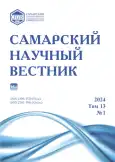Некоторые результаты петрографического изучения неолитической керамики стоянки Лужки II
- Авторы: Андреев К.М.1, Кулькова М.А.2
-
Учреждения:
- Самарский государственный социально-педагогический университет
- Российский государственный педагогический университет им. А.И. Герцена
- Выпуск: Том 13, № 1 (2024)
- Страницы: 75-84
- Раздел: Исторические науки
- URL: https://journal-vniispk.ru/2309-4370/article/view/263416
- DOI: https://doi.org/10.55355/snv2024131201
- ID: 263416
Цитировать
Полный текст
Аннотация
В представленной статье вводятся в научный оборот первые итоги петрографического изучения неолитической керамики стоянки Лужки II. Всего было проанализировано 22 образца от сосудов орнаментированных наколами (8 обр.), оттисками гребенчатого штампа (9 обр.), их сочетанием (1 обр.), ногтевидными насечками (2 обр.), а также лишь поясками ямочных вдавлений под срезом венчика (2 обр.). Петрографический анализ керамики позволяет установить минералогический состав глин и отощителей, выявить рецептуру керамического теста, определить температуру и условия обжига, а также предположить возможные источники сырья. По итогам микроморфологического изучения в коллекции стоянки Лужки II выделяется две группы посуды. Для первой характерно использование в качестве отощителя песка и шамота, а для второй, состоящей из двух образцов, только песка. В целом можно резюмировать, что все рассмотренные сосуды изготовлены из тощих глин, преимущественно гидрослюдистых с содержанием кластического материала от 18% до 35%. В качестве отощителя всегда выступал песок, в основном его доля около 45%, концентрация шамота не превышает 20%, его размером 0,7–1,3 мм. Условия долговременного обжига сосудов стабильные при температуре в основном +700…+800°C в окислительной среде.
Полный текст
Открыть статью на сайте журналаОб авторах
Константин Михайлович Андреев
Самарский государственный социально-педагогический университет
Автор, ответственный за переписку.
Email: konstantin_andreev_88@mail.ru
кандидат исторических наук, доцент кафедры отечественной истории и археологии
Россия, г. СамараМарианна Алексеевна Кулькова
Российский государственный педагогический университет им. А.И. Герцена
Email: kulkova@mail.ru
доктор геолого-минералогических наук, профессор кафедры геологии и геоэкологии
Россия, г. Санкт-ПетербургСписок литературы
- Сомов А.В. Новые стоянки эпохи неолита в лесостепном Поволжье // LII Урало-Поволжская археологическая конф. студентов и молодых ученых. Пермь: Изд-во ПГНИУ, 2020. С. 64–68.
- Васильев И.Б., Выборнов А.А. Неолит Поволжья. Куйбышев: Изд-во КГПИ, 1988. 112 с.
- Выборнов А.А. Средневолжская культура // История Самарского Поволжья с древнейших времен до наших дней. Каменный век. Самара: Изд-во СНЦ РАН, 2000. С. 177–215.
- Выборнов А.А. Неолит Волго-Камья. Самара: Изд-во СГПУ, 2008. 490 с.
- Агапов С.А., Васильев И.Б., Кузьмина О.В., Семенова А.П. Срубная культура лесостепного Поволжья (итоги работ Средневолжской археологической экспедиции) // Культуры бронзового века Восточной Европы. Куйбышев: Изд-во КГПИ, 1983. С. 6–58.
- Андреев К.М., Кулькова М.А., Сомов А.В. Технология изготовления неолитической керамики Среднего Поволжья по данным петрографического анализа // Краткие сообщения Института археологии. Вып. 263. М.: Изд-во ИА РАН, 2021. С. 378–393.
- Корохина А.В., Бельский В.Н. Петрографический и элементный анализ керамики поселения Глубокое Озеро-2 (первые археометрические данные) // Stratum plus. 2021. № 2. С. 197–218. doi: 10.55086/sp212197218.
- Растегаева М.Н. Керамическая петрография: история метода и современное состояние // Материалы по археологии и истории античного и средневекового Причерноморья. 2022. № S1. С. 110–125. doi: 10.53737/2713-2021.2022.36.62.004.
- Лычагина Е.Л., Кулькова М.А., Жижин С.П. Итоги петрографического анализа керамики с энеолитических памятников Средней Камы // Труды Камской археолого-этнографической экспедиции. 2021. № 19. С. 11–19. doi: 10.24412/2658-7637-2021-19-11-19.
- Батуева Н.С., Кулькова М.А., Кульков А.М. Первые результаты петрографического анализа неолитической керамики Верхнего и Среднего Прикамья // Труды Камской археолого-этнографической экспедиции. Вып. XV. Пермь: Изд-во ПГГПУ, 2019. С. 11–17.
- Бобринский А.А. Гончарство Восточной Европы. Источники и методы изучения. М.: Наука, 1978. 272 с.
- Бобринский А.А. Гончарная технология как объект историко-культурного изучения // Актуальные проблемы изучения древнего гончарства: колл. монография. Самара: Изд-во СГПУ, 1999. С. 5–109.
- Васильева И.Н. О происхождении гончарства // Современные проблемы археологии России. Т. 1. Новосибирск: Изд-во ИАЭ СО РАН, 2006. С. 243–245.
- Васильева И.Н. Ранненеолитическое гончарство Волго-Уралья (по материалам елшанской культуры) // Археология, этнография и антропология Евразии. 2011. № 2 (46). С. 70–81.
- Васильева И.Н. Гончарные традиции населения средневолжской культуры (к вопросу о многокомпонентном составе) // XXI Уральское археологическое совещание, посв. 85-летию со дня рожд. Г.И. Матвеевой и 70-летию со дня рожд. И.Б. Васильева. Самара: Изд-во СГСПУ; ООО «Порто-Принт», 2018. С. 17–19.
- Васильева И.Н., Выборнов А.А. Время появления и динамика распространения неолитических керамических традиций в Поволжье // Поволжская археология. 2016. № 3 (17). С. 104–123.
Дополнительные файлы











